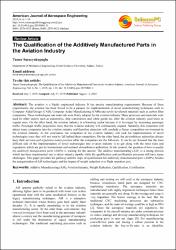| dc.contributor.author | Saraçyakupoğlu, Tamer | |
| dc.date.accessioned | 2019-12-29T14:32:12Z | |
| dc.date.available | 2019-12-29T14:32:12Z | |
| dc.date.issued | 2019 | en_US |
| dc.identifier.issn | 2376-4813 | |
| dc.identifier.issn | 2376-4821 | |
| dc.identifier.uri | https://hdl.handle.net/11363/1588 | |
| dc.description.abstract | The aviation is a highly engineered industry. It has precise manufacturing requirements. Because of these
requirements, the aviation has been forced to be a pioneer for implementation of novel manufacturing techniques such as
Computer Aided Design (CAD), Computer Aided Manufacturing (CAM) and newly-developed materials such as carbon fiber
composites. These technologies and materials were firstly adopted by the aviation industry. Many processes and materials were
used by other sectors such as automotive, ship construction and white goods etc. after the aviation industry used those as
regular ones. On the other hand, the aviation industry is a booming sector because it is leveraged by increasing passenger
traffic. Passenger traffic projections show that the aviation industry will continuously expand. Naturally, this expansion will
attract many companies into the aviation industry and therefore attraction will conclude a fiercer competition environment in
the aviation industry. At the conclusion, the companies in the aviation industry will look for implementation of novel
technologies since they will not want to fall behind their competitors. On the other hand, the airworthiness authorities always
keep their decision and regulation maker position while the companies are the followers. It can be put forward that the most
difficult side of the implementation of novel technologies into aviation industry is to get along with the strict rules and
regulations which are put by international and national airworthiness authorities. In this context, the question of how to qualify
the additively manufactured parts (AMPs) is waiting for the answer. The additive manufacturing (AM) is a strong process
which has been implemented into aviation industry rapidly while the qualification and certification processes still have many
challenges. This paper provides the pathway and the steps of qualification for additively manufactured parts (AMPs) besides
the categorization of AM technologies and the impact of weight reduction over flight operation cost. | en_US |
| dc.language.iso | eng | en_US |
| dc.publisher | Science Publishing Group 1 Rockefeller Plaza, 10th and 11th Floors, New York, NY 10020 U.S.A. | en_US |
| dc.relation.isversionof | 10.11648/j.ajae.20190601.11 | en_US |
| dc.rights | info:eu-repo/semantics/openAccess | en_US |
| dc.rights | Attribution-NonCommercial-NoDerivs 3.0 United States | * |
| dc.rights.uri | http://creativecommons.org/licenses/by-nc-nd/3.0/us/ | * |
| dc.subject | Additive Manufacturing (AM) | en_US |
| dc.subject | Aviation Industry | en_US |
| dc.subject | Weight Reduction | en_US |
| dc.subject | Qualification | en_US |
| dc.subject | Certification | en_US |
| dc.title | The Qualification of the Additively Manufactured Parts in the Aviation Industry | en_US |
| dc.type | article | en_US |
| dc.relation.ispartof | American Journal of Aerospace Engineering | en_US |
| dc.department | Mühendislik ve Mimarlık Fakültesi | en_US |
| dc.authorid | https://orcid.org/0000-0001-5338-726X | en_US |
| dc.identifier.volume | 6 | en_US |
| dc.identifier.issue | 1 | en_US |
| dc.identifier.startpage | 1 | en_US |
| dc.identifier.endpage | 10 | en_US |
| dc.relation.publicationcategory | Makale - Uluslararası Hakemli Dergi - Kurum Öğretim Elemanı | en_US |



















